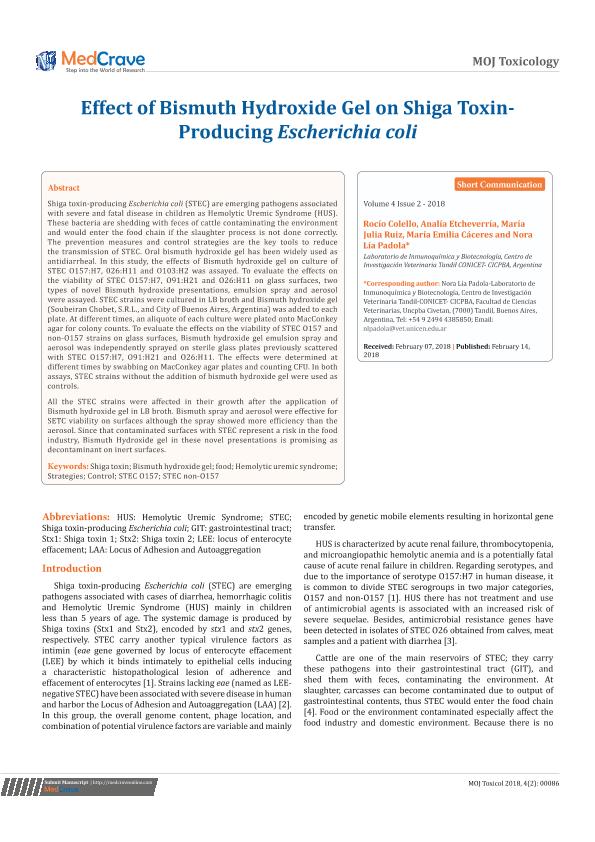Artículo
Effect of Bismuth Hydroxide Gel on Shiga Toxin Producing Escherichia coli
Colello, Rocío ; Etcheverría, Analía Inés
; Etcheverría, Analía Inés ; Ruiz, María Julia
; Ruiz, María Julia ; Cáceres, María Emilia
; Cáceres, María Emilia ; Padola, Nora Lía
; Padola, Nora Lía
 ; Etcheverría, Analía Inés
; Etcheverría, Analía Inés ; Ruiz, María Julia
; Ruiz, María Julia ; Cáceres, María Emilia
; Cáceres, María Emilia ; Padola, Nora Lía
; Padola, Nora Lía
Fecha de publicación:
02/2018
Editorial:
MedCrave Group
Revista:
MedCrave Online Journal of Toxicology
ISSN:
2379-6294
Idioma:
Inglés
Tipo de recurso:
Artículo publicado
Clasificación temática:
Resumen
Shiga toxin-producing Escherichia coli (STEC) are emerging pathogens associatedwith severe and fatal disease in children as Hemolytic Uremic Syndrome (HUS).These bacteria are shedding with feces of cattle contaminating the environmentand would enter the food chain if the slaughter process is not done correctly.The prevention measures and control strategies are the key tools to reducethe transmission of STEC. Bismuth hydroxide gel has been widely used asantidiarrheal. In this study, the effects of Bismuth hydroxide gel on culture ofSTEC O157:H7, 026:H11 and O103:H2 was assayed. To evaluate the effects onthe viability of STEC O157:H7, O91:H21 and O26:H11 on glass surfaces, twotypes of novel Bismuth hydroxide presentations, emulsion spray and aerosolwere assayed. STEC strains were cultured in LB broth and Bismuth hydroxide gel(Soubeiran Chobet, S.R.L., and City of Buenos Aires, Argentina) was added to eachplate. At different times, an aliquote of each culture were plated onto MacConkeyagar for colony counts. To evaluate the effects on the viability of STEC O157 andnon-O157 strains on glass surfaces, Bismuth hydroxide gel emulsion spray andaerosol was independently sprayed on sterile glass plates previously scatteredwith STEC O157:H7, O91:H21 and O26:H11. The effects were determined atdifferent times by swabbing on MacConkey agar plates and counting CFU. In bothassays, STEC strains without the addition of bismuth hydroxide gel were used ascontrols.All the STEC strains were affected in their growth after the application ofBismuth hydroxide gel in LB broth. Bismuth spray and aerosol were effective forSETC viability on surfaces although the spray showed more efficiency than theaerosol. Since that contaminated surfaces with STEC represent a risk in the foodindustry, Bismuth Hydroxide gel in these novel presentations is promising asdecontaminant on inert surfaces.
Archivos asociados
Licencia
Identificadores
Colecciones
Articulos(CIVETAN)
Articulos de CENTRO DE INVESTIGACION VETERINARIA DE TANDIL
Articulos de CENTRO DE INVESTIGACION VETERINARIA DE TANDIL
Citación
Colello, Rocío; Etcheverría, Analía Inés; Ruiz, María Julia; Cáceres, María Emilia; Padola, Nora Lía; Effect of Bismuth Hydroxide Gel on Shiga Toxin Producing Escherichia coli; MedCrave Group; MedCrave Online Journal of Toxicology; 4; 1; 2-2018; 1-3
Compartir
Altmétricas



